Fiber internet service is often called the gold standard of residential internet connections thanks to the fact that a fiber internet connection can easily provide a 10x speedier connection than ordinary coax cable. Fiber-to-the-Home (FTTH) deployments by Verizon Fios and AT&T Fiber are capable of 4K video conferencing and ultra-fast file uploads. Such connections also entail few worries about bandwidth in households characterized by six simultaneously streaming TV sets and serious multiplayer gamers.
Of course, internet backbone connections have long used fiber. It is the last-mile spans between the backbone and customer residences that are experiencing a big upswing. Multimode fiber is used in relatively short runs, typically within single buildings or between adjacent buildings under single ownership, such as on a college campus.
Fortunately there are standards for fiber optic cable jacket colors that help clarify the kind of optical cable in use for specific runs. Single-mode fiber optic cables have a yellow jacket, while orange indicates multimode. Aqua denotes 10 Gb/sec laser-optimized 50-micron optical fiber cable from Lucent Technologies, used to help distinguish it from older 50 and 62.5-micron multimode fiber cabling. Not all manufacturers use this specific color-identification system, so aqua is also sometimes used for 50-micron fiber cabling that differs from TIA standards in performance and distance capabilities. The TIA-598-C standard dictates that colored-jacket cables be used almost exclusively in intra-building applications, and certain cable jacket colors specify varying degrees of fire resistance.
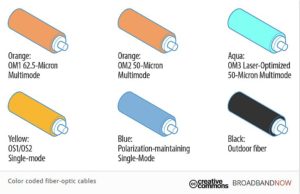
There is a fiber cable color standard called TIA-598-C. It does not include outdoor cables because most of these contain a black carbon component in their jackets to protect from sunlight UV and other harsh elements. TIA-598-C also only covers cables containing a single type of fiber. Cables that contain more than one type of fiber have printed identification on the jacket to identify the fiber types inside.
TIA-598-C dictates that aqua jacketing only be used on multimode, laser-optimized fiber optic cable classified as OM3 grade. (As an aside, the OM designations pertain to multimode fiber. They come from the international ISO/IEC 11801 standard and indicate a particular level of performance. OM1 is for is for standard 62.5-micron multimode glass. OM2 is for standard 50-micron glass. OM3 is for enhanced 50-micron glass (capable of 10 gigabit Ethernet out to 300 m). OM4 denotes enhanced 50-micron glass capable of 10 gigabit Ethernet out to 550 m. There are also OS levels which pertain to single-mode fiber. OS1 applies to standard single-mode glass while OS2 refers to a higher performing, low-water peak single-mode glass.)
The TIA-492AAAC-A standard defines OM3 cables as being 850-nm and having an EMB of 2000/500 MHz*km, with the ability to support 10 Gb/sec Ethernet for 300 m, or Gigabit Ethernet up to 1 km. (EMB is a measure of a multimode fiber’s ability to minimize the distortion of the transmitted optical signal. The higher the EMB, the lower the optical signal distortion.) However, some manufacturers use aqua covering on sub-OM3, 950 MHz*km EMB cable.
When working with fiber optic cable, faults are generally introduced by kinking that arises in fishing the fibers through wall or ceiling cavities, over-tightening staples and securing hardware, or allowing passersby to step on fiber laid out on the floor. Due to the large core of multimode fiber, splices can be done by means of hardware fittings that align the cores and, similarly, threaded terminations are user-friendly.
In contrast, single-mode optical fiber is installed in long underground or aerial spans, primarily by specialized crews belonging to utilities or their contractors. Splices must be cleaved, polished and heat-fused. Equipment required for this kind of work includes large excavators, bulldozers, high-capacity dump trucks and elaborate troubleshooting and splicing equipment with temperature-controlled vans and lots of electronic instrumentation, notably optical time-domain reflectometers.
Optical TDRs are available from many manufacturers: Tektronix, Megger, Siglent, Tech Systems Electronics. Trek Equipment, Keysight, Fluke and others. They are basically TDR technology that uses light waves. As with TDR technology for lower frequencies, these instruments can locate faults including discontinuities and reflections in cable, connectors and terminations, spools of wire in a warehouse, and so forth.

An OTDR typically contains a laser diode source, a photodiode detector, and a highly accurate time base. The laser emits a pulse of light at a specific wavelength, and this pulse of light travels along the fiber DUT. As the pulse moves down the fiber portions of the transmitted light reflect/refract or scatter back to the OTDR photodetector. The intensity of this returning light and the time elapsing for its arrival back at the detector denotes a loss value (insertion and reflection), the type of problem, and the location of the reflection event in the fiber link. Light returns to the photodetector through several mechanisms that include Rayleigh scattering and backscattering, Fresnel reflection, and absorption.
OTDRs can read out optical return loss (ORL) and reflectance which can help diagnose conditions where there is more loss than expected at a specific location in the fiber. The total fiber attenuation can also be assessed because the amount of backscatter provides an indication of this value.
These same principles are used to calculate distance measurements. The end of the fiber link or a fiber break generates a Fresnel reflection because a break or unterminated fiber end is also a change in material media (glass to air).

OTDRs today can be categorized basically as either hand-held devices for field use or more capable benchtop instruments. Another variable is the length of fiber. Products designed for long-haul applications typically have higher dynamic range that would be unnecessary for testing shorter links.
Usability features also vary by product, which is yet another reason the intended application for the OTDR should be the most important factor in product selection. For example, a light weight product might not be necessary for a stationary test, but if the testing is to be performed by technicians climbing cell towers or working in an otherwise active setting, weight, as well as features like battery life and ruggedization of the product enclosure become more important.
There are several OTDR operational parameters that can generally be adjusted to handle the particular situation at hand. For example, the pulse width determines the duration of the pulse emitted into the fiber link. A shorter pulse width is usually the choice for shorter cable lengths because it maximizes resolution and reduces energy output. Short pulse widths are also useful for evaluating cable problems that are close to the OTDR. Longer pulse width settings may be necessary for longer cable runs to get enough optical energy for backscatter at great distances.
The OTDR detector can become saturated by a highly reflective interface in the fiber link. The recovery period for the OTDR denotes a distance from the event, known as a dead zone. The dead zone is essentially a portion of the cable for which no data will be available. Air gaps, bad splices, flat fiber end faces (connectors or the fiber end) and other incidences producing high Fresnel reflection usually cause dead zones.
There are also distance range settings on OTDRs that control the range for the amount of cable displayed on the screen. This setting also defines the rate of pulse emission because each pulse must return to the detector before the next pulse is sent out. The operator must know the ballpark length of the fiber link to set this parameter. For example, if the instrument has settings of 10, 100, 200 and 500 km and the fiber link under test is 150 km, the 200 km setting is appropriate.
In general, operators may average multiple repetitions of the same test to get more accurate measurements. Longer averaging times from multiple repetitions of the same test will improve the measurement S/N but will take longer.
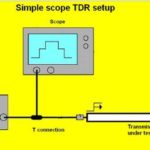
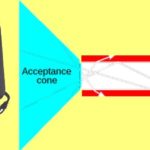
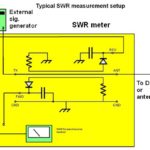
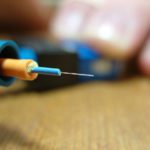
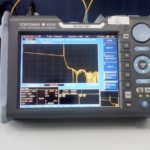

Leave a Reply
You must be logged in to post a comment.